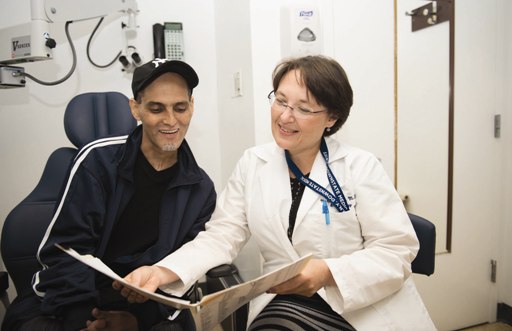Laryngology, Voice, and Swallowing
The larynx is the organ that enables sound creation using air pressure from the lungs. The vocal cords occupy the central region of the larynx and vibrate like stretched rubber bands when air passes across them. When dysfunction occurs in the larynx or the nerves that control it, the voice can be adversely affected. Larynx problems can stem from lesions, both benign and cancerous; from neurological disorders like vocal fold paralysis or medical illnesses; and from trauma, for example injury sustained during endotracheal intubation. These conditions may result in voice disturbances, swallowing disorders, airway obstruction or cancer of the larynx.
Symptoms of a serious voice disorder may include hoarseness (dysphonia), a weak or "breathy" voice, difficulty in projecting the voice or easy vocal fatigue, voice loss or breathing difficulties (stridor).
Physicians trained in this specialized field of otolaryngology diagnose and treat patients with many varieties of laryngeal pathology. Voice preservation and therapy (with emphasis on the professional voice) is an important aspect of the program.
Narrowing of the airway, called laryngotracheal stenosis, can lead to serious breathing obstruction, in some cases severe enough to require a tracheotomy, a surgical opening in the windpipe below the obstruction to enable breathing. An alternate solution, airway reconstruction to correct stenosis can restore natural breathing without the need for tracheotomy. In some cases, airway reconstruction can also restore airway function in patients who already have a tracheotomy, doing away with the need for the tracheal tube.
A variety of tools and techniques are employed to correct laryngotracheal stenosis. Airway dilation is the least invasive of these treatment techniques. The same-day procedure stretches the upper airway to increase airflow. The results are immediate but the procedure must be repeated over time. Endoscopic surgery results in less damage to healthy tissue, few breathing and swallowing problems and faster recovery times. If the problem cannot be corrected with airway dilation or endoscopic surgery, traditional surgical techniques are employed.
A number of conditions can lead to swallowing disorders including narrowing and obstructions, stroke and other problems of the brain and nervous system. The laryngology staff prefers, when possible, to employ a strategy combining swallowing therapy, dilation and the use of botulinum toxin (Botox) to relax the upper esophagus, clearing the way for food and liquids into the upper gastrointestinal tract.
Contact us
NewYork-Presbyterian Brooklyn Methodist Hospital
Center for Sleep and Airway Surgery



